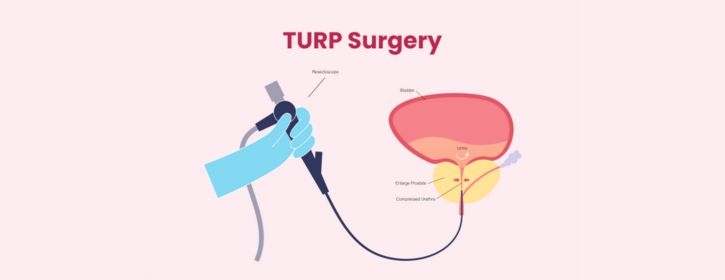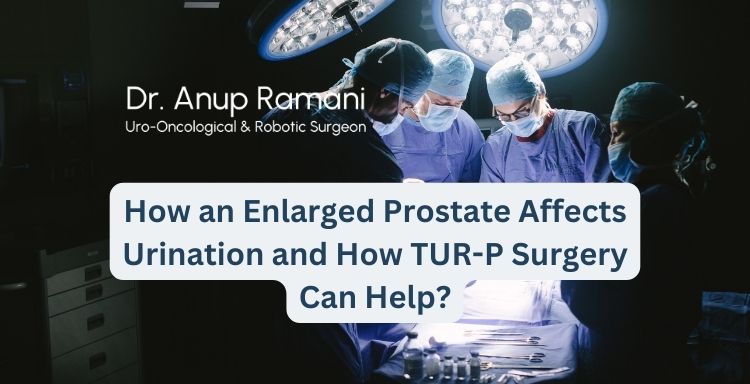Dr Anup Ramani @ Copyright 2024
By Dr. Anup Ramani
An enlarged prostate, medically known as benign prostatic hyperplasia (BPH), is a common condition in aging men. As the prostate enlarges, it presses against the urethra, leading to significant urinary difficulties. While medications may provide temporary relief, Transurethral Resection of the Prostate (TUR-P) surgery is a well-established and highly effective treatment that restores normal urination.
This article explores how an enlarged prostate affects urination, the need for surgical intervention, and how TUR-P surgery provides lasting relief.
How an Enlarged Prostate Affects Urination?
As men age, their prostate gland naturally grows larger. Although this growth is benign, it can lead to urinary issues because of its location surrounding the urethra. As the prostate enlarges, it compresses the urethra, leading to several urinary complications that can significantly impact quality of life.
1. Frequent Urination, Especially at Night:
- An enlarged prostate reduces bladder capacity, leading to frequent urges to urinate, particularly at night (a condition known as nocturia).
- Frequent nighttime urination disrupts sleep, causing fatigue and reduced energy levels throughout the day.
2. Weak Urine Stream and Difficulty Starting Urination:
- As the prostate compresses the urethra, it narrows the urinary passage, resulting in a weak and slow urine flow.
- Many men experience hesitancy, where they struggle to start urination despite the strong urge to go.
3. Incomplete Emptying of the Bladder:
- The enlarged prostate may obstruct the bladder’s ability to empty completely, leading to residual urine in the bladder.
- This results in frequent bathroom visits, discomfort in the lower abdomen, and an increased risk of urinary tract infections (UTIs).
4. Sudden, Uncontrollable Urges to Urinate:
- Many men experience an overwhelming urge to urinate but may struggle to reach the bathroom in time.
- This can lead to accidental leakage, which can be embarrassing and distressing.
5. Pain and Discomfort During Urination:
- Straining to urinate due to obstruction can cause pain, burning, or general discomfort.
- As the condition worsens, urination becomes more difficult and uncomfortable, negatively impacting daily life.
Why is TUR-P Surgery Essential?
Although lifestyle modifications and medications may offer temporary symptom relief, they do not address the root cause of an enlarged prostate. Transurethral Resection of the Prostate (TUR-P) is a well-established surgical procedure that removes excess prostate tissue, restoring normal urine flow and significantly improving urinary function.
This procedure has been widely used for decades and remains the gold standard in treating BPH due to its effectiveness and long-term benefits.

When is Surgery Necessary?
TUR-P surgery is recommended for men who experience severe or persistent urinary issues that do not improve with medication or other conservative treatments. You may need this procedure if you have:
- Severe urinary obstruction – Difficulty initiating or maintaining a steady urine stream due to prostate enlargement.
- Recurrent urinary tract infections (UTIs) – Infections caused by incomplete bladder emptying, creating an environment for bacterial growth.
- Bladder stones or kidney problems – Prolonged urine retention can lead to the formation of bladder stones or put excessive strain on the kidneys.
- Failure of medication – If prescribed treatments fail to provide adequate relief or cause undesirable side effects.
How Does TUR-P Surgery Benefit Patients?
TUR-P is a time-tested surgical technique that effectively treats an enlarged prostate by removing the obstructing tissue. Below is an overview of the procedure and its key benefits.
1. No External Incisions – Performed Through the Urethra
- Unlike open surgery, TUR-P does not require external cuts.
- A small surgical instrument is inserted through the urethra to remove excess prostate tissue.
2. Effective Prostate Tissue Removal
- The obstructing prostate tissue is carefully removed using a resectoscope, a specialized instrument with a small loop that cuts and removes tissue.
- This process allows for precise removal of tissue, ensuring optimal urine flow restoration.
3. Quick and Efficient Procedure
- The entire TUR-P procedure typically takes 40–60 minutes to complete.
- It is usually performed under spinal anesthesia, meaning the patient remains awake but does not experience pain.
4. Short Hospital Stay and Faster Recovery
- Most patients can walk the same evening after the surgery.
- The hospital stay is generally around two nights, allowing for a monitored recovery.
- A catheter is placed for about four days to help drain urine and assist in healing.
- Patients can return to work within one week and resume heavier activities, like exercise, after a month.
5. Long-Lasting Results with Minimal Risks
- TUR-P provides significant and lasting improvement in urinary function.
- The procedure has a lower risk of complications compared to open surgery.
- Possible side effects, such as mild discomfort or temporary urinary urgency, typically subside within a short period.
Conclusion
An enlarged prostate can severely impact urinary function, leading to frequent urination, a weak stream, and even complete urinary obstruction. While medications may offer short-term relief, TUR-P surgery remains the most effective long-term solution by removing excess prostate tissue and restoring normal urine flow.
If you are struggling with persistent urinary issues due to BPH, consulting with a specialist about TUR-P surgery can help you regain comfort, confidence, and an improved quality of life.
FAQs About Enlarged Prostate
What are the main symptoms of an enlarged prostate?
Common symptoms include frequent urination, weak urine flow, difficulty starting urination, and a sensation of incomplete bladder emptying.
Is TUR-P surgery painful?
No, TUR-P is performed under spinal anesthesia, so patients remain awake but feel no pain during the procedure. Recovery is also relatively comfortable compared to open surgery.
How soon can I resume daily activities after TUR-P?
Most patients can walk after 2-3 days, and can do in-house work. They can resume heavy activities after one month.
Are there any risks or complications with TUR-P?
The risk of complications is low. Some men may experience temporary urinary urgency or mild discomfort, which usually resolves quickly.
How long do the results of TUR-P surgery last?
TUR-P provides long-term relief, and most patients do not require additional treatments for many years, if not a lifetime.
About Author

Uro-Oncological & Robotic Surgeon
Dr. Anup Ramani is a robotic uro-oncological surgeon and an internationally recognized expert in robotic surgery for prostate, kidney and urinary bladder cancers. With more than two decades of robotic experience and 2,000+ robotic procedures, he brings unmatched precision and outcomes to complex uro-oncology cases. He is widely published in his field and is known for a personal, transparent approach-often spending over an hour in initial consultations to educate patients on its disease, surgery and recovery. His expertise spans prostate cancer treatment, kidney and bladder cancer surgery, adrenal gland surgery, kidney stone treatment, penile cancer surgery and enlarged prostate management. Dr. Ramani advocates the advantages of robotic surgery-magnified 3D vision, tremor-filtered precision, minimal scarring, lower blood loss and faster recovery-helping patients return to life sooner.
Table of Contents
Recent Blogs
Best Uro-Oncological surgeon
Specialist in India for Robotic Surgery
MCh, DNB, MS, DNB
Dr. Anup Ramani
CONTACT
Uro-Oncologist in India,
Best Robotic Surgeon for Uro Oncology Surgery
1407, One Lodha Place Next to World Towers Senapati Bapat Marg, Worli, Mumbai. 400013.
Dr Anup Ramani @ Copyright 2024 – Website Maintenance, SEO & GEO by Opal Infotech
- Partial penectomy is done in cases where glans and distal penis is involved with carcinoma.
- Partial penectomy is a type of organ-preserving surgery. Preservation of sexual and micturational function depends on the surgical dissection and reconstruction of residual urethra.
- Patients who develop stones in the kidney or ureter, often experience severe pain.
- This condition usually needs a procedure to remove the kidney stones.
- This procedure is called ureteroscopy and is performed very commonly.
- It does not require any cuts and hence it is painless.
- The procedure is performed with an endoscope inserted through the penis under spinal anesthesia.
- The scope is inserted through the penis into the kidney and stones are dissolved with a laser.
- The procedure takes about 40-50 minutes.
- A catheter (urine pipe) is kept after the procedure to drain the bladder. A stent is kept in the kidney at the same time.
- Patient is mobile and walking in the room the same evening.
- Hospital stay is one night and patient is discharged the next day after removal of the catheter.
- Patient has to come back after six weeks to remove the stent in the kidney.
- Patients can resume office a week after surgery and heavy activities like running, weight lifting, a month after the procedure.
- We offer fixed packages for this procedure which can be obtained by calling our helpline +91 9967666060.
- Men with an enlarged prostate, which is a normal ageing changes, often experiencing difficulty passing urine. This condition usually needs a procedure to trim the prostate and relieve the blockage.
- This procedure is called TURP and is performed very commonly.
- It does not require any cuts and hence it is painless.
- The procedure is performed with an endoscope inserted through the penis under spinal anaesthesia.
- The overgrown prostate is dissolved with a laser bloodlessly.
- The procedure takes about 40 minutes.
- A catheter (urine pipe) is kept after the procedure to drain the bladder.
- Patient is mobile and walking in the room the same evening.
- Hospital stay is two nights and patient is discharged with the catheter, which is removed after 4 days.
- Patients can resume office a week after surgery and heavy activities like running, weight lifting, a month after the procedure.
- We offer fixed packages for this procedure which can be obtained by calling our helpline +91 9967666060.
-
Robotic adrenalectomy is a sophisticated, complex surgery and it is very important that an experienced surgeon performs this surgery to avoid major complications.
-
Once the anesthesia is done, and patient positioned, three micro cuts (3mm each) are made in the patient’s abdomen.
-
The arms of the Da Vinci robot are connected to the cuts via ports (tubes).
-
Dr. Ramani then sits in the controlling console to perform the surgery.
-
On an average, a robotic adrenalectomy takes one hour.
-
The surgery is almost completely bloodless and there has never been any need to transfuse blood after surgery.
-
A urine catheter and bag to drain the bladder is inserted during surgery.
-
A tiny drain pipe may be inserted in the surgical side of the abdomen, connected to a bag.
-
Patient is kept nil-by-mouth the day of the surgery, with IV fluids. Sips of water are started the next day and solid food by day three.
-
The drain pipe, if kept, is removed in the room on day 2 after surgery.
-
The catheter is removed on day two after surgery.
-
Total hospital stay for robotic adrenalectomy is 4 nights (including night before surgery).
-
Post discharge, a doctor from the surgical team visits the patient at home/ hotel room once every day.
On the day of discharge, patient is totally self-sufficient. They are able to walk freely without any pain, dress themselves, shower, toilet and they do not need to hire any nurse or help at home. Almost all patients are back to work within 2 weeks of surgery.
Heavy activities like running, weight lifting can be resumed after a month
Follow up after an adrenalectomy is in the form of CT scans, once a year for 5 years.
Local patients usually meet Dr. Ramani after two weeks to discuss report.Outstation patients are counselled on a phone consultation.
- Dr. Ramani is one of the very few surgeons in India who has the expertise to perform a robotic surgery for bladder cancer, which includes removing the urinary bladder and reconstructing a new bladder robotically.
- Robotic radical cystectomy is an extremely sophisticated, complex surgery and it is very important that an experienced surgeon performs this surgery to avoid major complications.
- Once the anaesthesia is done, and patient positioned, six micro cuts (3mm each) are made in the patient’s abdomen.
- The arms of the Da Vinci robot are connected to the cuts via ports (tubes).
- Dr. Ramani then sits in the controlling console to perform the surgery.
- On an average, a robotic radical cystectomy with an ileal conduit takes 3-4 hours.
- The surgery is almost completely bloodless and there has never been any need to transfuse blood after surgery.
- A urine catheter and bag to drain the new bladder is inserted during surgery.
- Two tiny drain pipe in inserted in the surgical side of the abdomen, connected to a bag.
- Patient is kept nil-by-mouth for 4 days after surgery with IV supplementation of patient’s daily requirements of calories, fats, carbohydrates, proteins and electrolytes.
- The drain pipes are removed in the room on day 3-5 after surgery.
- Total hospital stay for radical cystectomy is 8 nights (including night before surgery).
- Post discharge, a doctor from the surgical team visits the patient at home/ hotel room once every day.
- On the day of discharge, patient is totally self-sufficient. They are able to walk freely without any pain, dress themselves, shower, toilet and they do not need to hire any nurse or help at home.
- Almost all patients are back to work within 6 weeks of surgery. Heavy activities like running, weight lifting can be resumed after two months.
Follow up after a radical a cystectomy is in the form of CT scans, once a year for 5 years.
Histopathology report: Local patients usually meet Dr. Ramani after two weeks to discuss report.
Outstation patients are counselled on a phone consult. Depending on the report, patient may or may not need chemotherapy after surgery.
If chemo is needed, patients may choose to get it done with a medical oncologist of their choice or avail the services of one of the four medical oncologists on our team.
- Robotic partial nephrectomy is a sophisticated, complex surgery and it is very important that an experienced surgeon performs this surgery to avoid major complications. Robotic radical (total) nephrectomy is
- relatively easier but still requires significant experience to consistently deliver results.
- Once the anaesthesia is done, and patient positioned, five micro cuts (3mm each) are made in the patient’s abdomen.
- The arms of the Da Vinci robot are connected to the cuts via ports (tubes).
- Dr. Ramani then sits in the controlling console to perform the surgery.
- On an average, a robotic radical nephrectomy takes one hour and a robotic partial nephrectomy takes about an hour and half.
- The surgery is almost completely bloodless and there has never been any need to transfuse blood after surgery.
- A urine catheter and bag to drain the bladder is inserted during surgery.
- A tiny drain pipe in inserted in the surgical side of the abdomen, connected to a bag.
- Patient is kept nil-by-mouth the day of the surgery, with IV fluids. Sips of water are started the next day and solid food by day three.
- The drain pipe is removed in the room on day 3 after surgery. The catheter is removed on day two after surgery.
- Total hospital stay for radical/partial nephrectomy is 4 nights (including night before surgery).
- Post discharge, a doctor from the surgical team visits the patient at home/ hotel room once every day.
- On the day of discharge, patient is totally self- sufficient.
- They are able to walk freely without any pain, dress themselves, shower, toilet and they do not need to hire any nurse or help at home.
- Almost all patients are back to work within 2-3 weeks of surgery.
- Heavy activities like running, weight lifting can be resumed after a month.
- Follow up after a radical/partial Nephrectomy is in the form of CT scans, once a year for 5 years.
- Local patients usually meet Dr. Ramani after two weeks to discuss report.
- Outstation patients are counselled on a phone consultation.







